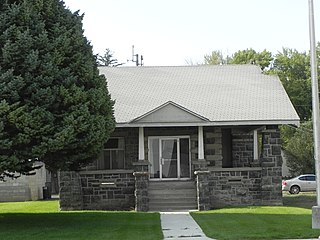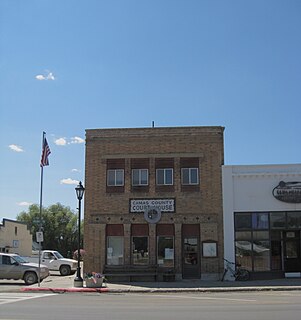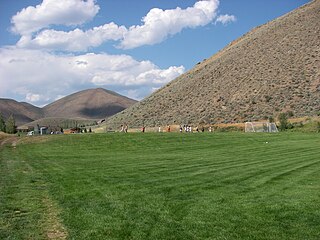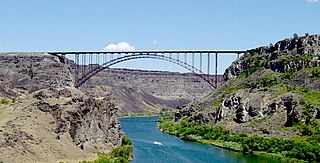Logan County was a county in Idaho Territory and later the state of Idaho from 1889 to 1895.
Logan County was the subject of multiple controversies during its six-year existence. Alturas County, Logan County's parent county, was Idaho Territory's most politically powerful county in 1889, with 1/6th of all legislators residing within the county to include the lower House Chairman, Mr. H.Z. Burkhart of Hailey. [1] Burkhart naturally opposed an effort to create Logan and Elmore counties from the southern and western portion of Alturas County. Other members of the legislature ultimately were successful in passing the counties' organic legislation on February 7, 1889. Burkhart and J.P. Clough, Legislative Council President from Lemhi County, separately challenged the legality of the act creating Logan County, contending that a group of legislators from both houses reconvened after adjournment in an effort to pass the legislation. Their opponents contended that the gentlemen vacated their positions prior to adjournment, resulting in the selection of new leaders for both the House and Legislative Council. The Supreme Court of Idaho Territory ruled against the gentlemen and the U.S. Supreme Court affirmed the ruling on appeal. [2] [3] [4] [5]
The creation of Logan County clearly marked a significant transition of political power going into the Statehood era. In the 1890 census, Logan County had an enumerated population of 4,169 across 16 precincts and Elmore County had 1,870 residents across 11 precincts, leaving Alturas with 2,620 residents across 15 precincts. Had the 1889 controversy been settled in favor of Alturas, it would have had 8,659 residents across 42 precincts and would have ranked as the 3rd most populous county behind Bingham and Latah counties. [6]
Shoshone, in present day Lincoln County was established as the temporary county seat by the 1889 statute. Later, Bellevue was selected as the county seat with only a majority of votes at the October 1, 1890 general election. County residents in Shoshone unsuccessfully challenged the validity of the election to the Idaho Supreme Court, claiming a 2/3 majority was required by the Idaho Constitution. [7]
The legislature again furthered the controversy on March 7, 1891 when it abolished Alturas and Logan counties, created Lincoln and Alta counties, and established Hailey and Shoshone as county seats. The Idaho Supreme Court ruled the act unconstitutional on June 3, 1891. This effectively restored Alturas and Logan counties with county seats at Bellevue and Hailey. [8]
Finally, on March 5, 1895, the legislature succeeded at what it attempted to do in 1891 by combining Logan and Alturas Counties into a new county called Blaine with its county seat at Hailey. Two weeks later on March 18, Lincoln County was created from the southern portion of Blaine County, containing the exact boundary and county seat established in 1891. The Idaho Supreme Court again weighed in on the matter in 1896. This time, it held the creation of Blaine County to be constitutional, finalizing the abolishment of Logan County effective from the creation date of Blaine County. [9]

Lincoln County is a county located in the U.S. state of Idaho. As of the 2010 census, the population was 5,208. The county seat and largest city is Shoshone. The county is named after President Abraham Lincoln. The Idaho Territory was created in 1863, during the Lincoln Administration of 1861–65.

Gooding County is a county located in the U.S. state of Idaho. As of the 2010 census, the population was 15,464. Its county seat is Gooding. The county was created by the Idaho Legislature on January 28, 1913, by a partition of Lincoln County. It is named for Frank R. Gooding, the 7th governor and a United States Senator from Idaho.

Elmore County is a county in the U.S. state of Idaho. As of the 2010 census, the population was 27,038. The largest city and county seat is Mountain Home.

Camas County is a county in the southern portion of the U.S. state of Idaho. The county seat and largest city is Fairfield. The county was established 105 years ago in 1917 by the Idaho Legislature with a partition of Blaine County on February 6. It is named for the camas root, or Camassia, a lily-like plant with an edible bulb found in the region, that Native Americans and settlers used as a food source. As of the 2020 census, the population was 1,077, making it the second-least populous county in the state.

Butte County is a rural county located in the U.S. state of Idaho. As of the 2020 census, the population was 2,574, making it the third-least populous county in Idaho. Its county seat and largest city is Arco. The county was established in 1917 from parts of Bingham, Blaine, and Jefferson counties. The county gained territory in the Clyde area from Custer County in 1937 to reach its present boundary.

Blaine County is a county in the U.S. state of Idaho. As of the 2020 United States Census, the population was 24,272. The county seat and largest city is Hailey. It is also home to the Sun Valley ski resort, adjacent to Ketchum.

Bellevue is a city in Blaine County in the central part of the U.S. state of Idaho. The population was 2,287 at the 2010 census, up from 1,876 in 2000.

Hailey is a city in and the county seat of Blaine County, in the Wood River Valley of the central part of the U.S. state of Idaho. The population was 7,960 at the 2010 census, up from 6,200 in 2000. Hailey is the site of Friedman Memorial Airport (SUN), the airport for the resort area of Sun Valley/Ketchum, 12 miles (19 km) north. The town of Bellevue is a few miles south. From 1882 to 1895, Hailey was the county seat of now-defunct Alturas County.

The Territory of Idaho was an organized incorporated territory of the United States that existed from March 3, 1863, until July 3, 1890, when the final extent of the territory was admitted to the Union as Idaho.

The Territory of Oklahoma was an organized incorporated territory of the United States that existed from May 2, 1890, until November 16, 1907, when it was joined with the Indian Territory under a new constitution and admitted to the Union as the state of Oklahoma.
Alturas County was a county in Idaho Territory and later the state of Idaho from 1864 to 1895. It covered an area larger than the states of Maryland, New Jersey, and Delaware combined. Most present-day southern Idaho counties were created at least in part from the original Alturas County area. The name Alturas comes from a Spanish word for "mountain summits" or "mountainous heights."

Rocky Bar is a ghost town in Elmore County, Idaho, United States. At its height in the late 19th century Rocky Bar boasted a population of over 2,500 and served as county seat of Alturas County from 1864 to 1882. It was also the original county seat of Elmore County when it was created in 1889. :)

The Magic Valley is a region in south-central Idaho constituting Blaine, Camas, Cassia, Gooding, Jerome, Lincoln, Minidoka, and Twin Falls counties. It is particularly associated with the agricultural region in the Snake River Plain located in the area. The northern Magic Valley region — particularly Blaine and Camas Counties — is also known as the Wood River Valley after the Big Wood River.

The Wood River Valley is a region in the western United States in south-central Idaho. Located in Blaine County, it is named after the Big Wood and Little Wood Rivers, which flow through the area.

The Idaho Republican Party (IDGOP) is the Idaho state affiliate of the United States Republican Party, headquartered in Boise.

David Logan was an American attorney and politician in the territory of and later state of Oregon. A native of Illinois, he moved to Oregon in 1850 where he served in the Oregon Territorial Legislature and in the Oregon Constitutional Convention. A founder of the Oregon Republican Party, he also served as mayor of Portland.

James Helmick Beatty was a United States District Judge of the United States District Court for the District of Idaho.

Thomas J. Bowers was a chief justice of the Idaho Territorial Court from July 18, 1868 to April 9, 1869. The court preceded the Idaho Supreme Court, established when Idaho became a state in 1890.
Hugh W. Weir was a chief justice of the Idaho Territorial Court from 1888 to 1889. The court preceded the Idaho Supreme Court, established when Idaho became a state in 1890.